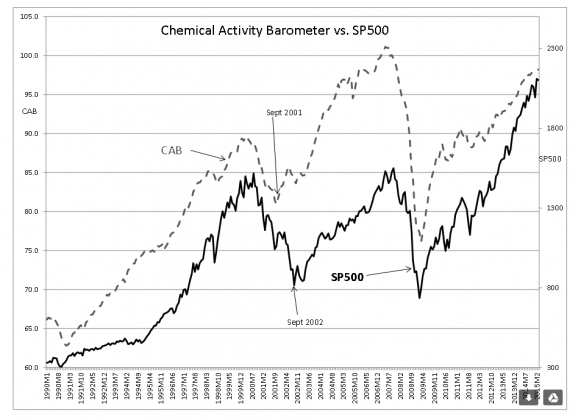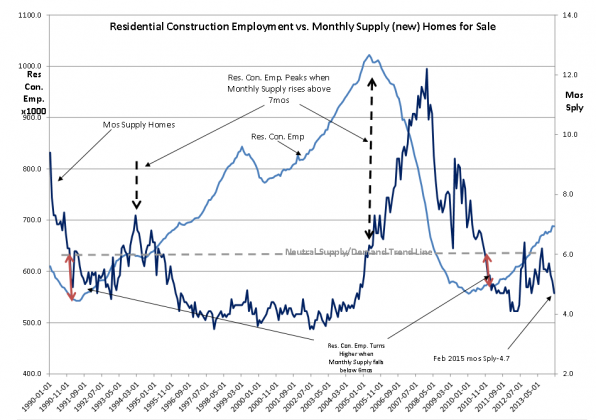“Davidson” submits:
The Chemical Activity Barometer vs. SP500(top chart) ($SPY) & Residential Construction Employment vs. Monthly Supply New Homes for Sale(bottom chart) continue in their positive trends with data this week. Data like this is a fundamental measure of economic activity. It is good at forecasting how investors are likely to feel about owning equities over the long term, but even though one may see short term patterns between the data and market prices one should not expect any useful forecast for short term traders.
The broad economy continues to expand. Equity markets historically trend higher as long as economic expansion continues. Clearly residential housing continues to lag as does Residential Construction Employment. Housing has been constrained by continued tight credit even with the Fed believing that it has created adequate credit. The issue remains that the Fed by its QE actions has caused lower mortgage rates through their desire to inject liquidity into the financial system. However, lower mortgage rates make the engine of home building. which is a substantial engine of our economy, unprofitable to banks except to only a small number of borrowers with excellent credit and very low historical rates. If mortgage rates were closer to 5.5%-6% (rather than the 3.75% we see today) and T-Bill rates remain less than 1%, then we would in all likelihood have sufficient credit spreads to permit banks to lend down the FICO score credit ladder as they have done historically.
Fed-engineered low mortgage rates creates tight credit conditions. Fed actions are more deflationary than inflationary. The Fed should sell the assets they acquired in 2009-2012 into the market and normalize credit conditions. Higher mortgage rates with T-Bill rates remaining under 1% would let banks lend profitably to housing sector. We would see employment soar and the economy accelerate.
Look at the trend for Residential Construction Employment. If one looks at the longer historical trend, one sees that while 1.022mil in April 2006 represented excess employment during the sub-prime housing boom, today is not unreasonable to expect a fully recovered housing market to employ this many individuals. From the current level of 687,000 another 400,000-500,000 new hires carries a 7x multiplier in other jobs elsewhere in the economy based on a Mortgage Bankers Assoc study. Yes, housing has a huge impact economically!
I expect credit markets to normalize even without the Fed reversing its position. Markets are larger than any single player and will rebalance over time on their own as investors seek higher returns vs. the historically low fixed income returns available today.
I continue to recommend that investors add to Equities with its Better Returns/Lower Risk and shift away from Fixed Income with its Low Returns/Much Higher Risk.

